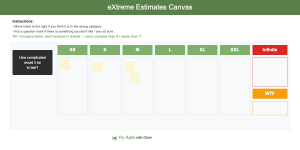eXtreme Estimates – Facilitator’s Guide
A long due manual, here is the facilitator’s guide to eXtreme Estimates, a workshop we designed from scratch in 2011 […]
A long due manual, here is the facilitator’s guide to eXtreme Estimates, a workshop we designed from scratch in 2011 with a few Octo colleagues, as our teams we growing very frustrated with typical agile estimate technique existing at the time (=poker planning).
I refined the practice over probably a hundreds of sessions across time and continents, but here is the original description for reference, still standing:
Workshop Overview
What is eXtreme Estimates?
A collaborative estimation technique that allows teams to:
- Estimate everything at once rather than item by item
- Iterate on confidence through group discussion
- Build shared understanding through conversation
Core Principles
- Global System Thinking – View the entire backlog holistically
- Facilitation as Conversation – Everyone talks, contradictions are explored
- Questions & Learning – Continuous improvement through variations
 The eXtreme Estimates System
The eXtreme Estimates System
Step 1: Place Cards
- Lay out all items to be estimated
- Move quickly (FAST approach)
- Initial placement based on gut feeling
Step 2: Improve Through Iteration
- Shake until stable – Keep adjusting positions until consensus emerges
- Use concrete criteria:
- Concrete indicators – Tangible measures of complexity
- Proxy indicators – “How complex is it to test when it is done?”
- Continue iterations until the team reaches stability
Step 3: Choose Yardsticks
- Select 2 reference items per category
- These become anchors for relative sizing
- Ensure yardsticks are well-understood by all
Step 4: Talk Numbers
- Apply numerical values using a scale
- Discuss and align on final estimates
Facilitation Guidelines
Creating the Right Environment
- Facilitate like a conversation
- Encourage everyone to speak
- Create space for contradictions and debate
- Keep energy flowing
Reading the Room
- Observe body posture to gauge confidence:
- Leaning forward = engaged and confident
- Arms crossed = skeptical or uncertain
- Standing back = low confidence
Checking the progress
- Hand vote for confidence check (you can repeat it over time)
- 1 = Random (no confidence)
- 2 = Not random, but not reliable
- 3 = It’s OK, but a lot will change if we give it a second look
- 4 = We will probably find that a lot of these are exact
- 5 = It’s quite relevant for the project/release
Talking Numbers – Practical Tips
Choose Your Scale
Pick a gross scale that works for your team:
- Fibonacci: 3, 5, 8, 13, 21…
- Exponential: 2, 4, 8, 16…
Key Questions to Ask
- For each category:
- What’s the minimum complexity/effort?
- What’s the maximum complexity/effort?
- For total calculation:
- What’s our velocity prediction?
- What assumptions are we making?
Language Tips
- Say “prediction” instead of “estimates”
- Reference: Johanna Rothman – “Predict the Unpredictable”
- Always report any assumptions made during estimation
Best Practices
Do’s
- Keep energy high and pace quick
- Encourage open discussion
- Make criteria visible to all
- Document assumptions
- Celebrate reaching consensus
Don’ts
- Don’t get stuck on perfect accuracy
- Avoid lengthy debates on single items
- Don’t skip the confidence check
- Never force consensus
Workshop Materials Needed – easy to adapt to virtual
- Index cards or sticky notes for all backlog items – this one is 90% of your preparation time
- Large wall or table space for card placement
- Markers for writing
- Timer for keeping pace
- Scale reference chart visible to all
For questions or coaching, reach out from the contact form
Learn the best practices from a professional coach.
I provide agile management and role training to deliver results, from startups to global enterprises.